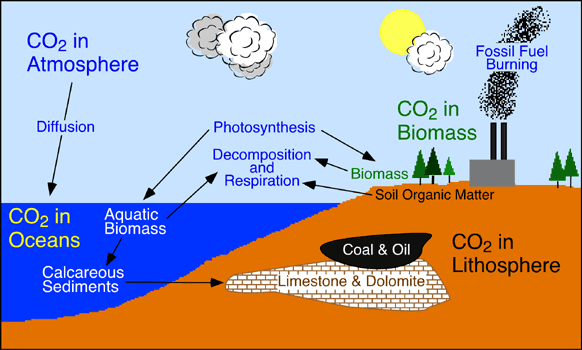Carbon is stored in the following five major sinks (1) As organic molecules found in the biosphere (2) As the gas carbon dioxide in the atmosphere (3) As organic matter in soils (4) In the Lithosphere as fossil fuels and sedimentary rock (5) In the oceans as dissolved atmospheric carbon dioxide and as calcium carbonate shells in marine organisms.
The carbon cycle is the circulation of carbon in the form of the simple element and its compounds through nature. The source of carbon in living things is carbon dioxide (CO2), from air or dissolved in water. Algae and green plants (producers) use CO2 in photosynthesis to make carbohydrates, used in the processes of metabolism tomake all other compounds in their tissues and those of animals that consume them (herbivores). The carbon may pass through several levels of herbivores and carnivores (consumers). Animals and (at night) plants return the CO2 to the atmosphere as a byproduct of respiration. The carbon in animal wastes and the bodies of organisms is released as CO2, in a series of steps, by decay organisms (decomposers), chiefly bacteria and fungi. Some organic carbon (the remains of organisms) has accumulated in the earth's crust in fossil fuels, limestone, and coral. The carbon of fossil fuels, removed from the cycle in prehistoric times, is being returned in vast quantities as CO2 via industrial and agricultural processes, some accumulating in the oceans as dissolved carbonates and some staying in the atmosphere Here is an illustration of the carbon cycle

